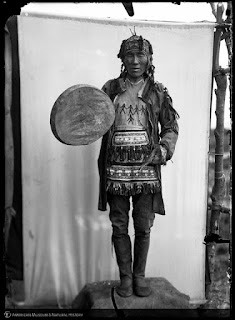This essay is the third in a series on the failure of leading 20th century mythologists or religionists to uncover significant antecedents of the religions they studied. The first considers the work of Joseph Campbell and the second addresses Raimon Panikkar's Limitations, and the fourth concerns Mircea Eliade's Limitations.
Dr. Alice C. Linsley
Castaneda considered don Juan his "teacher" while another shaman, don Genaro is described as his "benefactor" (Tales of Power, p. 226). Castaneda claims that don Genaro's actions had an extraordinary effect on him. "Every time I had come into contact
with him I had experienced the most outlandish sensory distortion." (Tales of Power, p.6)
Castaneda had a voracious appetite for the occult. At one point, he sought advice from Yogi Chen, a practitioner of esoteric Buddhism on how to produce a “double” of himself. Yogi Chen replied that there were methods for producing up to six emanations of oneself. “But why bother? Then you only have six times as much trouble.”
While Castaneda's works reveal an expansive imagination and fanciful literary style, his anthropological research is undisciplined, lacking in factual substance, and entirely anecdotal. It is as if he read what he could find about shamanism and then invented the perfect shamans to befriend him. His tales include all the classic elements of shamanic practice: drug-induced visions, progressive levels of skill at hunting, mystical bodyless flights, and rituals to gain the help of spirits. However, the tells are there! Castaneda's writings do not reveal understanding of the place of shamanism in the history of religion.
From 1971 to 1982, Castaneda's books sold at least 10 million copies. Castaneda's most popular titles, "A Separate Reality," "Journey to Ixtlan" and "Tales of Power," sold 10,000 copies in 2006, 8 years after the author's death. None of Castaneda's titles have ever gone out of print -- an impressive achievement for any author. His books became international best-sellers and have been translated into some 17 languages.
Castaneda's books stirred widespread interest in shamanism. It hardly mattered that his claims were debunked. His books are listed as nonfiction and don Juan and don Genaro are fictional characters. Nevertheless, having read Journey to Ixtlan and Tales of Power, I understand the appeal of his work. There is a freshness to the dialogue and at times a compelling glimpse of shamanic life, in spite of the fictional character of the works.
Castaneda's Limitations
I may have more first-hand experience of shamans than Castanedo. I have sat through shamanic cleansing rituals in sweat lodges, and I conducted a year-long correspondence with a Umani Lenape shaman who I invited to speak to my World Religions students. I am not a nay-sayer when it comes to the realness of their occult powers. It is seductive.
My intention is to clarify the distinction between the offices of shaman and priest, the oldest known religious offices. Both serve as intermediaries between their communities and the supernatural. They share some common symbols such as the Tree of Life, serpent symbolism, and the Sun as the emblem of the High God. However, they represent different worldviews, different ways of reasoning, and different practices.
Underlying shamanism is the belief that there are powerful spirits who cause imbalance and disharmony in the world. The shaman’s role is to determine which spirits are at work in a given situation and to find ways to appease the spirits and restore balance or harmony. This often involves use of psychoactive substances to induce a trance state. Rarely, does the shaman perform blood sacrifice. The hides used to make their drums come from animals that have been hunted for food.
Underlying the priesthood is belief in a supreme High God to whom humans must give an accounting, especially for the shedding of blood. The ancient laws and received traditions governing priestly ceremonies, sacrifices, cleansing and healing rituals clarify the role of the priest as one who offers sacrifice for the people according to sacred law.
Underlying the priesthood is belief in a supreme High God to whom humans must give an accounting, especially for the shedding of blood. The ancient laws and received traditions governing priestly ceremonies, sacrifices, cleansing and healing rituals clarify the role of the priest as one who offers sacrifice for the people according to sacred law.
In the priest's understanding, the High God holds the world in balance, and it is human actions that cause disharmony. Offending spirits (demons) contribute to the chaos. Therefore, priests are to discern or test the spirits, recognizing that evil spirits can masquerade as beneficent. In my experiences with shamans, I noted that they also recognize that the spirits sometimes lie. They have their own ways of testing the spirits. (Only one Spirit never lies.)
Shamans can be found among many populations around the world: Africa, Asia, Australia, and the Americas. They tend to serve small tribal communities or nomadic clans, whereas priests historically serve at shrines and temples under the authority of high kings and rulers. Another difference is the gender-transgressive (cross-dressing, transvestite) practice that occurs with shamanism. However, transvestism was prohibited among the Hebrew ruler-priest caste, the oldest known order of priests.


No comments:
Post a Comment